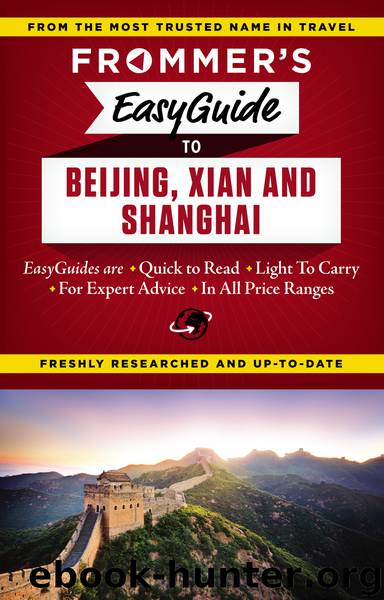Frommer's EasyGuide to Beijing, Xian and Shanghai by Graham Bond

Author:Graham Bond
Language: eng
Format: epub
Publisher: FrommerMedia
Published: 2015-11-29T16:00:00+00:00
The temple’s perimeter has undergone massive and rather glitzy redevelopment, finished with parks, plazas, malls, and a new monorail. To the north is a giant square, which boasts a large pool of fountains, benches, and retail shops lining the mall. A water-fountain-and-light show kicks off nightly at 8pm. Stretching south is a grand boulevard known as the Great Tang All Day Mall (Da Tang Bu Ye Cheng), punctuated with a series of huge bronze statues of historical personalities, including one of Xuanzang himself.
Admission RMB50, plus an additional RMB40 to climb the tower. Daily 8am–5pm. Subway: Da Yan Ta.
Shaanxi History Museum (Shanxi Lishi Bowuguan) MUSEUM Xi’an’s best museum may have a provincial focus, but Shaanxi’s astonishingly rich history and archaeological finds make this one of the country’s top museums. Around 375,000 items ranging from the Neolithic period to the later years of dynastic rule are held in three chronologically organized exhibition halls, none of which are particularly large, making this one of China’s more accessible and concise dips into its generally dizzying history.
Hall 1 gets underway a million years ago, ramps things up with Neolithic finds, before diving wholeheartedly into the stunning filigree bronze-work of the Zhou (1046–256 b.c.), which stands testament to an elaborate ritualized culture. Turn the corner into the Qin (221–206 b.c.) section of the hall to find a small battalion of Terracotta Warriors staring menacingly at you. Though their number are fewer here than at the archaeological site at Lintong, visitors are able to get right up close to the huge figures, making it the place to land your close-up photograph.
Hall 2 features exhibits from the Han (226 b.c.–a.d. 220) and Wei (a.d. 220–534), but China’s gallop into its golden age becomes clear in hall 3, which features the increasingly elegant and extravagantly colored statuettes of the Sui (581–618) and Tang (618–907). Perhaps the most startling exhibits come in the last hall. From the Song (960–1279) period comes the stunning Zhongshan Grotto, complete with a giant seated Buddha and two walls of 10,000 miniature acolytes. Later exhibits from the globetrotting Ming (1368–1644) include stunning ceramic tomb guardians that point to a lively trade with the outside world. There’s a trader from Africa and a fanciful depiction of a man on horseback battling a leopard.
English, French, and Korean audio guides can be rented from the front desk for RMB30 (RMB100 deposit), but ludicrously, this doesn’t include earphones, so bring your own if you want to avoid another RMB10 hit. The guide frustrates with a heavy accent and a numbing focus on numbers, sizes, and dates. However, it’s still worth having in your pocket. Though every item in the museum is labeled in English, only a handful give any additional detail, and the guide can help to bridge the gap. Allow 2 hours for your entire visit and don’t forget to bring your passport.
91 Xiaozhai Dong Lu. http://e.sxhm.com. 029/8525-4727. Free Admission. Visitor numbers are restricted to 2,500 in the morning and 1,500 in the afternoon, so get there early and take your passport.
Download
This site does not store any files on its server. We only index and link to content provided by other sites. Please contact the content providers to delete copyright contents if any and email us, we'll remove relevant links or contents immediately.
China Rich Girlfriend by Kwan Kevin(3885)
The Silk Roads by Peter Frankopan(3751)
Annapurna by Maurice Herzog(2834)
Hot Thai Kitchen by Pailin Chongchitnant(2803)
Full Circle by Michael Palin(2764)
Okonomiyaki: Japanese Comfort Food by Saito Yoshio(2387)
City of Djinns: a year in Delhi by William Dalrymple(2130)
The Ogre by Doug Scott(2105)
Photographic Guide to the Birds of Indonesia by Strange Morten;(2086)
Tokyo by Rob Goss(2014)
Vietnam, Cambodia, Laos & Northern Thailand by Lonely Planet(2009)
Tokyo Geek's Guide: Manga, Anime, Gaming, Cosplay, Toys, Idols & More - The Ultimate Guide to Japan's Otaku Culture by Simone Gianni(1941)
Discover China Travel Guide by Lonely Planet(1860)
Everest the Cruel Way by Joe Tasker(1822)
China (Lonely Planet, 11th Edition)(1795)
Lonely Planet China(1748)
China Travel Guide by Lonely Planet(1736)
Top 10 Dubai and Abu Dhabi by DK Travel(1713)
Iranian Rappers And Persian Porn by Maslin Jamie(1706)
